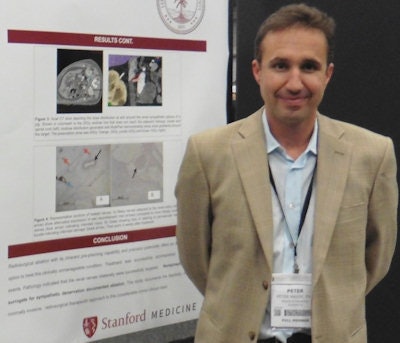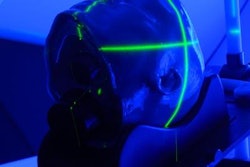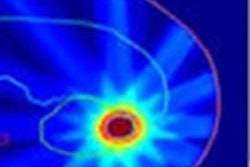
Radiation therapy is a mainstay treatment for a wide range of cancers. But, according to research presented at the American Association of Physicists in Medicine (AAPM) Annual Meeting in Austin, Texas, U.S., radiotherapy could also prove promising for treating conditions such as atrial fibrillation or hypertension.
Speaking at the meeting's John R Cameron Young Investigator Symposium, Svenja Ipsen from the University of Luebeck in Germany described the use of radiation to treat atrial fibrillation (AFib), a condition in which the electrical signals controlling the heartbeat become chaotic and cause the heart to beat irregularly. AFib, which increases the risk of suffering stroke, is usually treated using catheter ablation, but this is an invasive approach.
 Svenja Ipsen from the University of Luebeck spoke at AAPM Annual Meeting's John R Cameron Young Investigator Symposium.
Svenja Ipsen from the University of Luebeck spoke at AAPM Annual Meeting's John R Cameron Young Investigator Symposium."Ablative doses of ionizing radiation are used to treat cancer, so why not use this to treat AFib noninvasively?" said Ipsen, who conducted the research at the University of Sydney in Australia. Radiosurgery of the pulmonary veins has been proposed as a treatment for AFib, and previous studies have demonstrated that a dose of about 30 Gy is needed to ablate the target. The idea is to create nonconducting scar tissue that will block the AFib signals before they enter the heart.
One big challenge for this approach, however, is to image a beating heart accurately enough to direct radiation to the small, ring-like target without damaging nearby critical structures. "Our approach is to use entirely noninvasive tracking using an MRI-linac," Ipsen told the AAPM delegates.
To test the feasibility of MRI-guided treatment, Ipsen and colleagues quantified target motion ranges by imaging four volunteers with real-time cardiac MRI, under free breathing conditions. They found the mean respiratory-induced target motion was largest in the superior-inferior direction (10.2 mm). Smaller motion was seen in the anterior-posterior (2.5 mm) and right-left (1.9 mm) directions. Overall, results indicated that real-time MRI tracking of the pulmonary veins appears feasible.
The researchers then performed a radiotherapy planning study, with the treatment target defined as an ablation line at each pulmonary vein antrum, and safety margins ranging from 0 mm (perfect tracking) to 8 mm (untracked motion). Increasing the margins to encompass untracked motion resulted in excessive heart dose in all plans, implying that the reduced margins enabled by MRI tracking are essential. They also used Monte Carlo simulations to examine the influence of a 1-tesla magnetic field on the delivered dose distribution. The field had little impact and did not invalidate the dose calculations.
Ipsen concluded by describing an envisaged AFib treatment scenario, in which the patient undergoes CT and MRI pretreatment scans, followed by dose calculations and planning, with constant MR imaging applied to adjust the beam direction during treatment. "We hope to expand the horizons of radiosurgery beyond conventional use in cancer treatment," she said. "We hope to provide an alternative treatment for heart rhythm disorders."
Bringing the pressure down
Hypertension, or high blood pressure, is a common condition that puts sufferers at risk for heart disease, stroke, and kidney disease. For those with refractory hypertension, in whom standard treatments do not work, radiation therapy may provide another option. In a study chosen as one of this year's "Best in Physics" presentations at the AAPM Annual Meeting, Peter Maxim from Stanford University in Stanford, CA described his latest work in this area.
 Peter Maxim from Stanford University with his "Best in Physics" poster presentation.
Peter Maxim from Stanford University with his "Best in Physics" poster presentation.Blood pressure is regulated by nerve signals between the brain, heart, blood vessels, and kidneys. By ablating the nerves surrounding the main arteries to the kidney with radiation, it may be possible to disrupt these signals and interrupt the feedback loop that causes hypertension. "We have the tools to focus radiation so precisely, we can target the nerves responsible while sparing nearby healthy structures such as the spine and kidneys," Maxim said. "It's noninvasive and could be done in a single treatment."
Maxim presented a study assessing the safety and efficacy of stereotactic radiotherapy for treating refractory hypertension in a swine model. Twelve hypertensive pigs received 40 Gy radiation in a single fraction delivered to the renal nerves under image guidance. All animals survived to the six-month follow-up point with no adverse events. Microscopic evaluation four to six weeks after treatment showed evidence of damage to the nerves around the treated renal arteries.
The animals' plasma norepinephrine levels (measured as a surrogate for renal denervation) decreased by 63% on average during follow-up. Pathologic examination after the follow-up period revealed moderate damage to the nerves and minimal damage to nearby critical organs, highlighting the targeting accuracy. In this study, the researchers radiated the entire renal artery; future research will consider how much radiation should be used and precisely which areas should be irradiated.
Maxim says that the first human trial will start in the autumn of this year, in which 10-15 patients will be evaluated to demonstrate the safety of this approach. This will be followed by a larger trial to demonstrate efficacy. "If this works, it dwarfs anything that we're doing with cancer," he told medicalphysicsweb.
© IOP Publishing Limited. Republished with permission from medicalphysicsweb, a community website covering fundamental research and emerging technologies in medical imaging and radiation therapy.



















